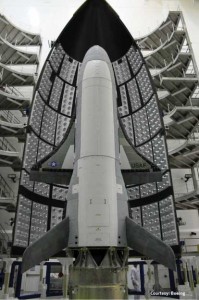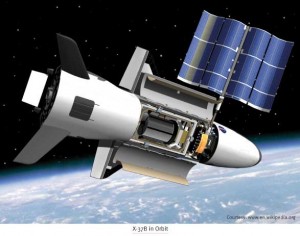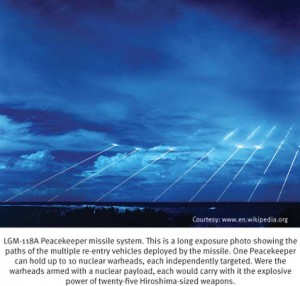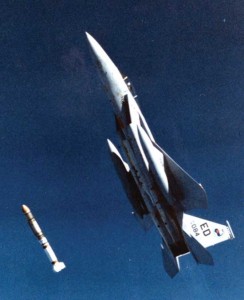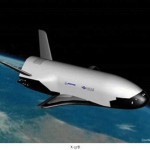The first orbital flight of X-37B (called as USA-212) the United State’s (US) space plane was launched on an Atlas V rocket from the Cape Canaveral Air Force Station, Florida on Apr 22, 2010. This aircraft has been placed into the low earth orbit (LEO). The craft is designed to remain in the orbit for nine months. However, the US agencies have not indicated about the stay-in-orbit period. After finishing the mission such aircraft are expected to de-orbit and land at the predestinated location (runway) on the earth. Fundamentally, this platform could be viewed as an updated version of the space shuttle1. However, this craft does not carry any crew, but relies on onboard sensors to undertake all tasks. Not much information is available of the actually payloads of board of this platform.
As per the US officials such aircraft are intended to serve as platform for experiments and to offer insights on transporting satellite sensors and other equipment to and from space. The US agencies are tightlipped about the exact mandate for the lunch. Also, no information is coming forward in regard to the exact purpose of such missions with one more mission planned for the future (another X-37 spacecraft it expected to fly by 2011).Chinese sources have claimed that the X-37B flight which would be the first space craft to carry out an autonomous re-entry in the history of the US programme might trigger an arms race in space. The ‘China Daily’ had described the launch of the X-37B as an US attempt to start an arms race in space. The Chinese analysts feel that such crafts hold potential military value. They can be used as platform for launching space weapons and also serve as combat-support systems. They can also destroy other nations’ satellites2. As per Mr John Pike, director of globalsecurity.org, one of the inherent values of the X-37 could be as a maneuverable satellite which could be used to look over China’s shoulder one day, yet evade any attempts to shoot it down3.
Since 1980s a concept is being floated called the “rods from god.” “¦ then they could make militaries capable enough to destroy underground, hardened nuclear facilities.
This experimental launch carried out by the US is not the attempt to weaponise the space by any state. In fact it was China which is now criticizing the US was instrumental in raising the ante in regards to security of space assets/satellites in the recent past. On January 11, 2007 China shocked the entire world by destroying its own aging weather satellite. They had launched a missile to destroy this satellite by using a kinetic kill vehicle (KKV) warhead.
This destruction of satellite had lead to the creation of huge debris in the space with a potential to harm other satellites orbiting in the space. This test by China was a clear depiction of its intent to prove to the world about its ASAT (anti satellite) capacity. In the past during mid-eighties both US and Russia (erstwhile USSR) had demonstrated this capacity however, they had stopped testing because of the debris issue.
Within a year of the Chinese ASAT test on February 21, 2008 the US used an opportunity to destroy its malfunctioning satellite to demonstrate its capability in this filed. The US military spy satellite (USA-193) within few days after its launch had started malfunctioning and its orbital decay (reduction in the height of the satellite’s orbit) had started. The satellite was expected to enter in the earth’s atmosphere. The US successfully destroyed this satellite by using SM-3 missile from one of its warships. The US missile had defragmented this satellite in very low orbits (240 km) just above the earth’s atmosphere to avoid the problem of debris4. Also, by doing a test from a warship the US had demonstrated that their ASAT weaponry/platform is fixable in nature5.
All the three incidents narrated above indicate the importance of space dominance for major powers. For last couple of decades space is being viewed as an area of great strategic advantage. The 1991 Gulf War demonstrated, among other things, what can happen when a nation that does not enjoy the benefits of space exploitation wages war against one that does. In that conflict, the US enjoyed a virtual monopoly on access to space-based surveillance, communications, and navigation support6.
In Kosovo conflict the NATO alliance reportedly used various satellite systems to their advantage.7 Similarly, in the Afghanistan theatre the overall concept of operations is dependent on inputs received from various satellites. The aircraft in such conflicts were guided from satellites for accurate delivery of bombs over the target. Many air assaults were made by using GPS guided weapons like JDAMS (Joint Direct Attack Munitions). In fact, the US had used the same technology when the Chinese Embassy in Belgrade was accidentally (?) bombed during the NATO air offensive against Yugoslavia8.
Today, states like the US are essentially not allowing any international treaty on banning the usage of space weapons because of their relevance for any Missile Defence system.
However, such usage of space technology predominantly since 1991 for the military purposes is not been challenged either by the UN or by any other nation. This is because the usage of the technology has been in the field of remote sensing, surveillance and reconnaissance, broadcasting and communications, and navigation and such usage is perceived fair. There could be two reasons for it. First, satellite technology is inherently a dual use technology. Satellite communication and navigation has many utilities in the non-military filed. Satellites are frequently been used for the purposes for identifying the weather patterns and for the purposes of land and water resources management.
The same satellites could offer information on military targets too. Second, for many years various manual, mechanical and electronic methods are being used for the purposes of military surveillance, communications, and navigation and satellites is just one of the new methods. Also, usage of satellite technology for these purposes does not violate any international legal regime. In short usage of satellite technology for military purposes per say has no restrictions. Such usage of satellite technology is known as ‘militarization of space’.
The problem arises when technological means are used for the purposes of damaging other country satellites or damaging own satellite and creating debris which in turn could cause damage to another countries space assets. Also, theoretical possibilities exist for putting weapons in the space which could be activated as per the requirement. This is called ‘weaponisation of space’. Presently, it appears that the extension of military weapons in the space could become a priority for space faring nations.
This is because they may need to project their civilian and military assets in the space. The danger to space assets could be from both space faring as well as space novice nations. To cause damage to other country’s space assets it is not mandatory to have possess space weapons. Any missile technology savy nation could develop ASAT technology. Also, ground based lasers could be used for jamming the satellites.
It is important to appreciate that all space weapons are not alike. There are differences in the physical principles of their usage. There could be different weapons for different targets. In general weapons could be categories into two broad types: (1) those that direct destructive energy to their targets without transporting significant mass and (2) those that must deliver significant mass to their targets for destructive effect. The subcategories of second category could be the weapons that rely on the kinetic energy of their own mass and velocity for destructive effect and those that deliver a more-conventional warhead with stored chemical energy for destructive effect9.
Space weapons are mostly perceived only as weapons which are used against satellites in space either from space or from ground. However, there is an additional category of weapons which could be deployed in space for the purposes attacks on the targets on the ground. Since 1980s a concept is being floated called the “rods from god.” If the technical and political hurdles for the development and deployment of such weapons could be overcome, then they could make militaries capable enough to destroy underground, hardened nuclear facilities.
Such weapon systems are perceived to consist of tandem satellites, one serving as a communications platform, the other carrying an indeterminate number of tungsten rods, each up to 20 feet in length and 1 foot in diameter. Such rods could be dropped on a target within 15 minutes notice from the earth control center. These roads would enter the earth’s atmosphere at an approximate speed of 36,000 feet per second. Upon impact, the rods would produce similar effects of an earth-penetrating nuclear weapon, without any radioactive fallout. This type of weapon relies only on kinetic energy to generate significant destructive force10.
In regard to ground based jammers some progress towards using lasers for the purposes of satellite jamming has already been done by China. As per reports they have used ground based lasers to target the US reconnaissance satellites. During August and September of 2006, China has used high-powered, ground-based lasers to blind the US reconnaissance satellites when they pass over China11. Here the purpose was not to destroy the US satellites but to make them useless over Chinese territory. It has also been reported that the US military was so alarmed by this Chinese activity that it has begun to carry out test attacks against its own satellites to determine the dimensions of this threat12.
The concerns in regard to security of space assets and control of space have been raised in some form or other since late 1950s. The US scientific community had opposed the idea of putting the overall space programme in the hands of military way during 195813. During those days the idea of space warfare had not developed but still the fear was there in the minds of civilian community that their own military may play a role of a spoiler for civilian space programme. Subsequently, apart for the erstwhile USSR few other states entered the space field and also the proliferation of missile technology took place. During last four to five decades the dependence of the US military on space assets has increased substantially. The number of space faring nations has also increased.
Throughout 1970s and 1980s the US had major concerns revolving around erstwhile USSR. During March 1983 the then US President Ronald Reagan had proposed the concept of Strategic Defence Initiative (SDI/Star Wars)-about the usage of ground based and space based systems to provide protection against any attack by strategic nuclear ballistic missiles. The successive US governments were not able to take the idea further because of technological un-viability of the concept. Today, having achieved few technological breakthroughs this idea is being projected under a new name called ‘Missile Defence Shield’. All these concepts demand engagement of the missile in the outer space.
Probably, that is one of the reasons why the US withdrew from the Anti-Ballistic Missile Treaty (ABM) with Russia in 2002. This treaty was signed between the US and erstwhile USSR during 1972. The withdrawal from this treaty may allow the US to test and build the Missile Defence System. Today, states like the US are essentially not allowing any international treaty on banning the usage of space weapons because of their relevance for any Missile Defence system.
There is one school of thought which feels that because of the collapse of the Berlin Wall the context of the space weaponization debate has changed radically. Deprived of the monolithic Soviet bogeyman, pro-weaponizers needed a new threat to prod their audience into action—so they more or less created one14. However, this argument is not entirely true. This is because even after the Cold War security threats still exist, may be in a different shape and with different actors. Particularly, in the space arena in the post Cold War era, China has emerged as a major player. Chinese intentions in regards to space weaponization are being questioned for last few years. By undertaking ASAT test in 2007 China has overtly revealed its aspirations.
Similarly, intents of other major space power like Russia need to be verified thoroughly. They are extremely uncomfortable about the US intentions in the arena of missile defence. This had become evident particularly when the former US President George Bush had signed deals to base interceptor missiles in Poland and radar in the Czech Republic. Finally, Barack Obama cancelled this plan which in certain quarters is being looked at as a diplomatic and military victory for Russia.
Before deciding to withdraw from the ABM treaty, the US administration had an alarming report available with them on issues related to space weaponization for their assessment. On January 11, 2001, a Space Commission headed by Mr Donald Rumsfeld had submitted its report to the US government suggesting that ‘space could be the next Pearl Harbor for the US’15. This assessment regarding the heightened nature for threat to its space assets had compelled the US administration to look for long-term remedies.
Chinese writings indicate that the PLA strategists are convinced that in future space will be one of the natural domains of war and that war in space will be an integral part of other military operations.
As an aftermath of the Rumsfeld Space Commission report the US government announced the need to develop a Space Based Space Surveillance (SBSS) project to develop a constellation of satellites to conduct Space Situation Awareness (SSA). The major focus of this constellation is to provide timely space situation awareness to meet up future space control operations. On May 20, 2004 a Boeing/Ball Aerospace & Technologies Corp team was awarded a $189 million contract by the US Air Force for the design and development of SBSS System. However, due to significant cost escalation and schedule delays the programme was restructured in early 2006. The launch of the initial satellite was delayed to April 2009 — a delay of about 18 months. A SBSS constellation is expected to provide the coverage required to ensure space superiority capability to the warfighter16.
It is likely that within few months of the submission of Rumsfeld Space Commission report 9/11 happened, which probably changed the nature of security discourse within the US and also in the rest of the world. Naturally, the attention of policy makers and military leadership was focused towards war on terror. Now, slowly with the war against terrorism remaining unresolved for almost a decade other important security related issues which had taken a backseat have started coming to the fore and weaponisation of space is one of them.
The last decade witnessed spurt in activities as far China’s space programme is concerned. Major successes were witnessed in regard to its manned programme and moon programme. The 2007 ASAT test indicate that the China is looking at the issues related to space weaponisation very seriously. For them space operations and space warfare are components the “informationalized,” or information age, warfare. Chinese writings indicate that the PLA strategists are convinced that in future space will be one of the natural domains of war and that war in space will be an integral part of other military operations. They are of the opinion that future enemy military forces are likely to depend heavily on information systems for military operations and hence China needs to break through the technological barriers and develop information system countermeasures in space.
Further they feel that since future military threats will primarily come in aerospace sector it is essential to combine information, firepower, and mobility. Some of them also believe that in future wars, space will be used to “carry out war between space platforms and to attack strategic surface and air targets.” For them the investment in lasers and other forms of directed energy and electromagnetic technologies is important. The ASAT technologies could include: satellite jamming technology, kinetic energy weapons, space planes that can transit and fight “up or down” in the upper atmosphere or space, and high-power laser microwave weapon systems weapons. The military strategists are also arguing for doctrinal changes. They feel that it is essential to have “space supremacy” as an integral part of battle domination along with other forms of supremacy over the battlefield17.
China appears to be working on a two pronged strategy in space arena. On one hand they have undertaken an ASAT test but simultaneously they are also pushing for disarmament agenda, at least overtly. Russia and China have proposed a new international treaty to ban the use of weapons in outer space. The new draft treaty was presented at the disarmament conference in Geneva during Feb 200818. However, the US has long opposed being bound by such an agreement. This draft has many loopholes. It talks only about weapons in space-but the problem could be from weapons fired from the earth like the missile launch by China for its 2007 ASAT. Putting this draft at the UN level is probably an attempt by Beijing to draw international attention away from its own growing counterspace programme. Russia has helped them in this regard because this allows them to put the US missile defence plans under pressure.
For states like US and China, lack of any arms control regime for space weapons could be said to be advantageous. The United Nations Outer Space Treaty (OST, 1967) contains an undertaking not to place in orbit any nuclear or any other weapons of mass destruction. However, it is felt that the provisions made in this treaty are not sufficient to account for the existence of any space weapons. China and the US are taking advantage of the serious limitations of this treaty. Presently, at the UN level there is no agreement on how to define space weapon because at times anything and everything could be defined as a space weapon.
China’s recent ASAT success comes from firing a piece of metal (KKV) that had no ammunition in it. Any piece of intentionally put debris in the space could act as a space weapon. It is also difficult to verify the intentions of any space faring nations in terms of its actual weaponisation programme. More so there are issues related to verification of such acts in case of establishment of any protocol because mostly it would be impossible to verify any claims made by the states towards space weaponisation. Besides the verification process would be very costly. In view of this few experts even argue that no arms control is better than bad arms control.
It is now obvious that powers like US and China are not interested in evolving a viable and robust space disarmament regime. A forecast published by the Military Space Transparency Project (MSTP)19 projects that second arms race can erupt in the space arena. This forecast highlights that by 2025 world may witness the acts of space warfare. It is felt that there is a relationship between critical dual-use technologies that may assist in the development of both peaceful commercial and destructive military applications.
Technological advances in technologies such as directed energy systems, artificial intelligence, nanotechnology, improvised Unmanned Aerial Vehicles and Launch Services will help states to develop satellite weapons20. Because of nature of existing and futuristic information networks space warfare technologies could proliferate easily.
At the backdrop of above it could be argued that space warfare is likely to become a reality for the future. It would present both the military and the diplomacy with a new tool to play power politics. It is expected that the first country to put weapons in space may have an advantage in this field. States are likely to draw lessons from the nuclear arms race philosophy in yesteryears which started with a view to maintain a monopoly of this type of weapon. Space weapons may even emerge as an alternative to existing nuclear deterrence mechanism within few years.
At the beginning of this 21st century the world is witnessing the existence of unified battlefield constituting of the five theaters of combat, namely, land, sea, air, cyber and space. It is expected that major portion of the latter half of the 21st century security makeup would be dominated by space.
Notes
- Stephen Clark, “Atlas rocket delivers Air Force spaceplane to orbit”, http://spaceflightnow.com/atlas/av012/100422launch/
- http://www.brahmand.com/news/US-new-spacecraft-to-trigger-arms-race-in-space/ 3723/1/11.html
- http://www.csmonitor.com/USA/Military /2010/0420/Air-Force-to-launch-X-37-space-plane-Precursor-to-war-in-orbit
- The debris starts melting once they enter the earth’s atmosphere.
- The three fourth of world constitutes of water and a ship based system offers more flexibility of satellite targeting.
- Z.M. Khalizad, The US and Rising China, Rand Corp., Santa Monica, 1999, p. 81.
- Dean Cheng, “Space and Chinese Views of Future Warfare,” 2001 CAPS-RAND PLA Conference.
- “China’s Intelligence and Internal Security Forces,” Jane’s Information Group, Alexandria, USA, October 1999, p. 74.
- Bob Preston et al, Space Weapons Earth Wars, Rand, 2002, pp.23-24.
- Michael Goldfarb, “The Rods from God”, Jun8, 2005, http://www.weeklystandard.com/Content/Public/Articles/000/000/005/700oklkt.asp
- Ian Easton, “The Great Game in Space”, Project 2049 Institute, project2049.net/publications.html
- Francis Harris, “Beijing secretly fires lasers to disable US satellites”, 26 Sep 2006, http://www.telegraph.co.uk/news/worldnews/1529864/Beijing-secretly-fires-lasers-to-disable-US-satellites.html
- National Affairs: Who should control space?, Time, Feb 17, 1958.
- Major Howard D. Belote, USAF, “The Weaponization of Space It Doesn’t Happen in a Vacuum”, Aerospace Power Journal, Spring 2000, p.49.
- “Rumsfeld Space Commission”, http://www.rightweb.irc-online.org/profile/Rumsfeld_Space_Commission
- “Space Based Space Surveillance (SBSS)”, http://www.globalsecurity.org/space/systems/sbss.htm
- Larry M. Wortzel, “Chinese People’s Liberation Army and Space Warfare” Emerging US–China Military Competition: A Project of the American Enterprise Institute, pp.2-7.Also, refer Astropolitics ,Volume 6, Issue 2, May 2008 , pp. 112–137.
- http://news.bbc.co.uk/2/hi/europe/7240796.stm
- http://www.spacetransparency.org/Space_Transparency/Home.html
- Matthew Hoey, Global Space Warfare Technologies: “Influences, Trends, and the Road Ahead”, http://cryptome.org/0001/space-war-tech.htm




